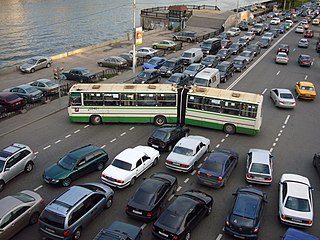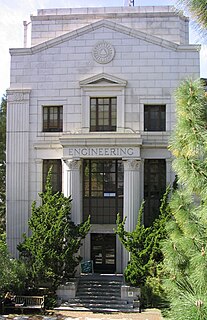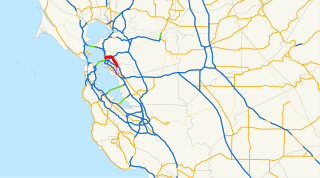California Partners for Advanced Transit and Highways (PATH) is a collaboration between the California Department of Transportation (Caltrans), UC Berkeley, other public and private academic institutions, and private industry. PATH's mission: applying advanced technology to increase highway capacity and safety, and to reduce traffic congestion, air pollution, and energy consumption. The organization recently celebrated its twentieth year.

The California Department of Transportation (Caltrans) is an executive department of the US state of California. The department is part of the cabinet-level California State Transportation Agency (CalSTA). Caltrans is headquartered in Sacramento.

The University of California, Berkeley is a public research university in Berkeley, California. It was founded in 1868 and serves as the flagship institution of the ten research universities affiliated with the University of California system. Berkeley has since grown to instruct over 40,000 students in approximately 350 undergraduate and graduate degree programs covering numerous disciplines.

Traffic congestion is a condition on transport networks that occurs as use increases, and is characterised by slower speeds, longer trip times, and increased vehicular queueing. When traffic demand is great enough that the interaction between vehicles slows the speed of the traffic stream, this results in some congestion. While congestion is a possibility for any mode of transportation, this article will focus on automobile congestion on public roads.
Caltrans provides a portion of PATH funding; the remaining funding comes from the United States Department of Transportation, other state and local agencies, and private industry. PATH supports the research of nearly 50 faculty members and 90 graduate students. Alexander Skabardonis, Adjunct Professor in the Department of Civil and Environmental Engineering at UC Berkeley, is the PATH Director.

The United States Department of Transportation is a federal Cabinet department of the U.S. government concerned with transportation. It was established by an act of Congress on October 15, 1966, and began operation on April 1, 1967. It is governed by the United States Secretary of Transportation.
As a collaborative organization, PATH has had many partners, including public agencies, universities, and private companies. Partners include the California Department of Transportation (Caltrans); the Federal Highway Administration; the Federal Transit Administration; the National Highway Traffic Safety Administration; the Metropolitan Transportation Commission; the California Highway Patrol; the University of California, Davis, Irvine, Los Angeles, and Riverside; Claremont Graduate University; University of Southern California; George Mason University; Virginia Tech; Massachusetts Institute of Technology; Honda; Toyota; SRI International Jet Propulsion Laboratory; Honeywell; General Motors; DaimlerChrysler; and the Ford Motor Company. It is administered by the Institute of Transportation Studies at UC Berkeley, and housed at UC Berkeley's Richmond Field Station.

The Federal Highway Administration (FHWA) is a division of the United States Department of Transportation that specializes in highway transportation. The agency's major activities are grouped into two programs, the Federal-aid Highway Program and the Federal Lands Highway Program. Its role had previously been performed by the Office of Road Inquiry, Office of Public Roads and the Bureau of Public Roads.

The National Highway Traffic Safety Administration is an agency of the Executive Branch of the U.S. government, part of the Department of Transportation. It describes its mission as "Save lives, prevent injuries, reduce vehicle-related crashes."

The California Highway Patrol (CHP) is a law enforcement agency of California. The CHP has patrol jurisdiction over all California highways and can act as the state police. They also have jurisdiction over city roads, and may conduct law enforcement procedures there.

The College of Engineering (CoE) is one of 14 schools and colleges at the University of California, Berkeley. Ranked third in the world, after the engineering programs at MIT and Stanford, according to U.S. News & World Report, it is considered among the most prestigious engineering schools in the world. Berkeley CoE is particularly well-known for producing many successful entrepreneurs; among its alumni are co-founders and CEOs of some of the largest companies in the world, including Apple, Boeing, Google, and Intel. The college was established in 1931 from a merger of the Colleges of Mechanics and the College of Civil Engineering. The College of Mining was integrated into the college in 1942. The college is currently situated in 14 buildings on the northeast side of the central campus, and also operates at the 150 acre Richmond Field Station. There are over 57,000 living graduates of the College of Engineering, living in all 50 states and nearly 100 countries, with the majority living in California.
The Texas A&M Transportation Institute (TTI) in College Station, Texas is the largest transportation research agency in the United States. Created in 1950, primarily in response to the needs of the Texas Highway Department, TTI has since broadened its focus to address all modes of transportation–highway, air, water, rail, pipeline, and automated/connected vehicles. TTI is a state agency and a member of the Texas A&M University System. TTI’s cooperative relationship with the Texas Department of Transportation has helped the Institute develop and implement work for numerous other sponsors.

State Route 13 is a state highway in California. It is a short loop in Alameda County currently built from Interstate 580 in Oakland to Interstate 80/Interstate 580 in Berkeley.

State Route 123 is a state highway in the U.S. state of California in the San Francisco Bay Area. Named San Pablo Avenue for virtually its entire length, SR 123 is a major north–south state highway along the flats of the urban East Bay in the U.S. state of California. Route 123 runs a relatively short 7.39 miles (11.9 km) between Interstate 580 in the south and Interstate 80 in the north. San Pablo Avenue itself, a portion of Historic US 40, continues well past these termini but without the Route 123 designation.
The National Traffic and Motor Vehicle Safety Act was enacted in the United States in 1966 to empower the federal government to set and administer new safety standards for motor vehicles and road traffic safety. The Act was the first law to establish mandatory federal safety standards for motor vehicles. The Act created the National Highway Safety Bureau. The Act was one of a few initiatives by the government in response to a increasing number of cars and associated fatalities and injuries on the road following a period when the number of people killed on the road had increased 6-fold and the number of vehicles was up 11-fold since 1925.
The Research and Innovative Technology Administration (RITA) is a unit of the United States Department of Transportation (USDOT). It was created in 2005 to advance transportation science, technology, and analysis, and to improve the coordination of transportation research within the department and throughout the transportation community.
Vehicular communication systems are computer networks in which vehicles and roadside units are the communicating nodes, providing each other with information, such as safety warnings and traffic information. They can be effective in avoiding accidents and traffic congestion. Both types of nodes are dedicated short-range communications (DSRC) devices. DSRC works in 5.9 GHz band with bandwidth of 75 MHz and approximate range of 300 m. Vehicular communications is usually developed as a part of intelligent transportation systems (ITS).
The Harmer E. Davis Transportation Library —also known as the Institute of Transportation Studies Library (ITSL), the Berkeley Transportation Library, or simply as the Transportation Library— is a transportation library at the University of California, Berkeley, devoted to transportation studies.

Boston Transportation Planning Review (BTPR), published in 1972, was a transportation planning program for metropolitan Boston, Massachusetts, which was responsible for analyzing and redesigning the entire area-wide transit and highway system in the 1970s. The major contractors involved were Alan M. Voorhees Company (Virginia), project manager; Skidmore, Owings and Merrill, architect; ESL Incorporated (California), air quality and acoustics. The program had close guidance from the national Transportation Research Board (TRB), a division of the US National Academy of Sciences. The first director of the program reporting to the Governor was Alan Altshuler; the project manager was Walter Hansen.

California's transportation system is complex and dynamic. Although known for its car culture and extensive network of freeways and roads, the state also has a vast array of rail, sea, and air transport. Several subway, light rail, and commuter rail networks are found in many of the state's largest population centers. In addition, with the state's location on the West Coast of the United States, several important ports in California handle freight shipments from the Pacific Rim and beyond. A number of airports are also spread out across the state, ranging from small general aviation airports to large international hubs like Los Angeles International Airport and San Francisco International Airport.
The Institute of Transportation Studies (ITS) at the University of California's Berkeley, Davis, Irvine, and Los Angeles campuses are centers for research, education, and scholarship in the fields of transportation planning and engineering. Faculty members, staff researchers, and graduate students comprise this multidisciplinary institute network of more than 400 people, which administers an average of $20 million in research funds each year. ITS Berkeley is an organized research unit with nine affiliated organizations and an eight-member advisory council.
The California Center for Innovative Transportation (CCIT) was a research organization at the University of California, Berkeley Institute of Transportation Studies.
The National Center of Excellence for Aviation Operators (NEXTOR) is part of a national alliance of research institutes with centers dedicated to the advancement of new ideas, the training of professionals, and the growth of knowledge in the field of aviation operations.
The AAA Foundation for Traffic Safety is a non-profit, charitable organization based in Washington, DC that is dedicated to saving lives through traffic safety research and education. Since its founding in 1947, the AAA Foundation has sponsored over 200 projects related to highway safety, covering topics such as distracted, impaired, and drowsy driving; road rage; graduated driver licensing; driver's education and training; and pedestrian safety. The AAA Foundation research agenda is centered on four priority areas: Driver behavior and performance, emerging technologies, roadway systems and drivers and vulnerable road users.
J. Karl Hedrick was an American control theorist and a Professor in the Department of Mechanical Engineering at the University of California, Berkeley. He made seminal contributions in nonlinear control and estimation. Prior to joining the faculty at the University of California, Berkeley he was a professor at the Massachusetts Institute of Technology from 1974 to 1988. Hedrick received a bachelor's degree in Engineering Mechanics from the University of Michigan (1966) and a M.S. and Ph.D from Stanford University.
Paramics is traffic microsimulation software developed by Quadstone Paramics. Quadstone Paramics also develops pedestrian microsimulation software called the Urban Analytics Framework.

Cambridge Systematics, Inc. is an independent, employee-owned transportation consultancy firm with corporate headquarters located in Medford, Massachusetts. Cambridge Systematics provides strategic planning and management services, objective analysis, and technology applications for passenger, commercial, freight, and transit systems to public and private sectors both nationally and internationally.
The Intelligent Transportation Systems (ITS) Institute is a national University Transportation Center headquartered at the University of Minnesota. The ITS Institute researches activities to enhance the safety and mobility of road-based and transit-based transportation, particularly in a northern climate and in rural environments. The ITS Institute focuses on human-centered technology, such as computing, sensing, communications, and control systems.

The UC Irvine Institute of Transportation Studies (ITS), is a University of California organized research unit with sister branches at UC Davis, and UC Berkeley. ITS was established to foster research, education, and training in the field of transportation. UC Irvine ITS is located on the fourth floor of the Anteater Instruction and Research Building at University of California, Irvine's main Campus, and also houses the UC Irvine Transportation Science graduate studies program.













